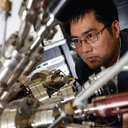[Pedigree survey in a family with hereditary protein S deficiency].
Fjalë kyçe
Abstrakt
Objective: To observe the clinical feature of familiar hereditary protein S deficiency(HPSD), and to explore the related gene mutations. Methods: A total of seven family members were enrolled in this study and examined during the June to September 2015. Medical histories of the families were analyzed to detect HPSD according to the diagnostic criteria. PROS1 genes of the proband and her family were analyzed. DNA was extracted from peripheral blood. The 15 exons and their intron-exon boundaries of PROS1 were amplified with PCR, and the PCR products were sequenced and analyzed to identify potential mutations. Medical histories from the family members died prior this study were also obtained. Results: Four out of 7 family members of 2 generations were diagnosed as HPSD. The proband suffered from pulmonary embolism, her elder brother suffered from cerebral infarction and her niece suffered from deep vein thrombosis. A missense mutation at the 1063 bp of cDNA(c.1063C>T)was detected in the exon 10 of PROS1, which resulted in arginine 355 to cysteine replacement in the first ball domain of laminin of the protein S(p.R355C). Conclusion: HPSD is an autosomal dominant genetic disease, patients often suffer from recurring vein thrombosis and pulmonary embolism. A missense mutation(c.1063C>T, p. R355C)of PROS1 was discovered in this Chinese family with HPSD, thus, this mutation might be the genetic basis responsible for these family members with HPSD .




